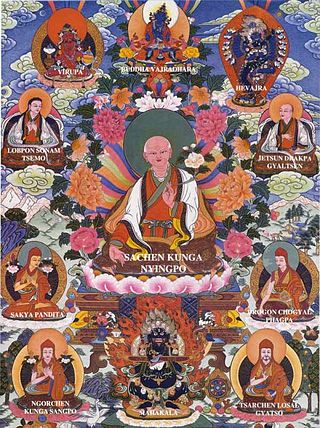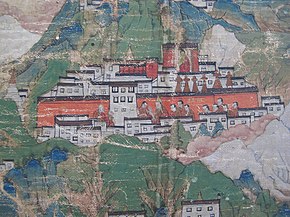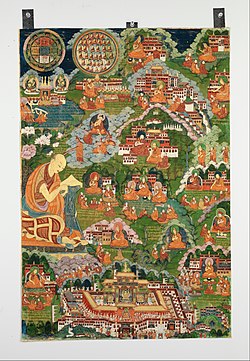
Tibetan Buddhism is a form of Buddhism practiced in Tibet, Bhutan and Mongolia. It also has a sizable number of adherents in the areas surrounding the Himalayas, including the Indian regions of Ladakh, Darjeeling, Sikkim, and Zangnan, as well as in Nepal. Smaller groups of practitioners can be found in Central Asia, some regions of China such as Northeast China, Xinjiang, Inner Mongolia and some regions of Russia, such as Tuva, Buryatia, and Kalmykia.

The Sakya school is one of four major schools of Tibetan Buddhism, the others being the Nyingma, Kagyu, and Gelug. It is one of the Red Hat Orders along with the Nyingma and Kagyu.

The Gelug is the newest of the four major schools of Tibetan Buddhism. It was founded by Je Tsongkhapa (1357–1419), a Tibetan philosopher, tantric yogi and lama and further expanded and developed by his disciples.

The Kagyu school, also transliterated as Kagyü, or Kagyud, which translates to "Oral Lineage" or "Whispered Transmission" school, is one of the main schools of Tibetan Buddhism. The Kagyu lineages trace themselves back to the 11th century Indian Mahasiddhas Naropa, Maitripa and the yogini Niguma, via their student Marpa Lotsawa (1012–1097), who brought their teachings to Tibet. Marpa's student Milarepa was also an influential poet and teacher.

Atīśa was a Buddhist religious leader and master. He is generally associated with his body of work authored at Vikramashila Monastery in Bihar, India. He was one of the major figures in the spread of 11th-century Mahayana and Vajrayana Buddhism in Asia, flowing from Tibet to Sumatra. He is recognised as one of the greatest figures of medieval Buddhism. Atiśa's chief disciple, Dromtön, was the founder of the Kadam school, one of the New Translation schools of Tibetan Buddhism, later supplanted by the Gelug tradition in the 14th century which adopted its teachings and absorbed its monasteries.

The Tibetan Buddhist canon is a compilation of the Buddhist sacred texts recognized by various schools of Tibetan Buddhism. The Canon includes the Kangyur, which is the Buddha's recorded teachings, and the Tengyur, which is commentaries by great masters on the Buddha's recorded teachings. The first translation into Tibetan of these manuscripts occurred in the 8th century and is referred to as the Ancient Translation School of the Nyingmas.

The Jonang is a school of Indo-Tibetan Buddhism. Its origins in Tibet can be traced to the early 12th century master Yumo Mikyo Dorje. It became widely known through the work of the popular 14th century figure Dolpopa Sherab Gyaltsen. The Jonang school's main practice is the Kālacakra tantra, and they are widely known for their defense of the philosophy known as shentong.
Lamrim is a Tibetan Buddhist textual form for presenting the stages in the complete path to enlightenment as taught by Buddha. In Tibetan Buddhist history there have been many different versions of lamrim, presented by different teachers of the Nyingma, Kagyu and Gelug schools. However, all versions of the lamrim are elaborations of Atiśa's 11th-century root text A Lamp for the Path to Enlightenment (Bodhipathapradīpa).

Jetsun Milarepa was a Tibetan siddha, who was famously known as a murderer when he was a young man, before turning to Buddhism and becoming a highly accomplished Buddhist disciple. He is generally considered one of Tibet's most famous yogis and spiritual poets, whose teachings are known among several schools of Tibetan Buddhism. He was a student of Marpa Lotsawa, and a major figure in the history of the Kagyu school of Tibetan Buddhism. He is also famous for the feat of climbing Mount Kailash.

Tsongkhapa was an influential Tibetan Buddhist monk, philosopher and tantric yogi, whose activities led to the formation of the Gelug school of Tibetan Buddhism.

The Rimé movement is a movement or tendency in Tibetan Buddhism which promotes non-sectarianism and universalism. Teachers from all branches of Tibetan Buddhism – Sakya, Kagyu, Nyingma, Jonang, Gelug, and Bon – have been involved in the promoting Rimé ideals.

Nyingma can be referred to as Ngangyur, is the oldest of the four major schools of Tibetan Buddhism. The Nyingma school was founded by Padmasambhava as the first translations of Buddhist scriptures from Pali and Sanskrit into Tibetan occurred in the eighth century. The establishment of the Tibetan Buddhism and the Nyingma tradition is collectively ascribed to Khenpo Shantarakshita, Guru Padmasambhava, and King Trisong Detsen, known as Khen Lop Chos Sum.

Jamgön Kongtrül Lodrö Thayé, also known as Jamgön Kongtrül the Great, was a Tibetan Buddhist scholar, poet, artist, physician, tertön and polymath. He is credited as one of the founders of the Rimé movement (non-sectarian), compiling what is known as the "Five Great Treasuries". He achieved great renown as a scholar and writer, especially among the Nyingma and Kagyu lineages and composed over 90 volumes of Buddhist writing, including his magnum opus, The Treasury of Knowledge.

Dromtön, Drom Tonpa or Dromtönpa Gyelwé Jungné was the chief disciple of the Buddhist master Atiśa, the initiator of the Kadam school of Tibetan Buddhism and the founder of Reting Monastery.
Geshe or geshema is a Tibetan Buddhist academic degree for monks and nuns. The degree is emphasized primarily by the Gelug lineage, but is also awarded in the Sakya and Bön traditions. The equivalent geshema degree is awarded to women.
Lojong is a contemplative practice in the Tibetan Buddhist tradition which makes use of various lists of aphorisms or slogans which are used for contemplative practice. The practice involves refining and purifying one's motivations and attitudes. There are various sets of lojong aphorisms; the most widespread text in the Sarma traditions is that of Chekawa Yeshe Dorje. There is also another set of eight lojong slogans by Langri Tangpa. In the Nyingma tradition, there is a list of seven lojong slogans which are part of the Dzogchen Nyingthig lineage.
The Taklung Kagyu is a sub-school of the Kagyu school of Tibetan Buddhism.
Geshe Langri Thangpa (1054–1123) is an important figure in the lineage of the Kadampa and Gelug schools of Tibetan Buddhism. He was born in Phenpo, as Dorje Senge. His name derives from Langtang, the area in which he is said to have lived. He was a Kadampa master, and disciple of Potowa Rinchen Sel.
Buddhists, predominantly from India, first actively disseminated their practices in Tibet from the 6th to the 9th centuries CE. During the Era of Fragmentation, Buddhism waned in Tibet, only to rise again in the 11th century. With the Mongol invasion of Tibet and the establishment of the Mongol Yuan dynasty (1271–1368) in China, Tibetan Buddhism spread beyond Tibet to Mongolia and China. From the 14th to the 20th centuries, Tibetan Buddhism was patronized by the Chinese Ming dynasty (1368–1644) and the Manchurian Qing dynasty (1644–1912) which ruled China.
Patsab Nyima Drakpa (1055-1145?) was a Tibetan Buddhist scholar and translator of the Sarma era. He was a monk at Sangpu monastery and traveled to Kashmir where he translated Buddhist Madhyamika texts.





















